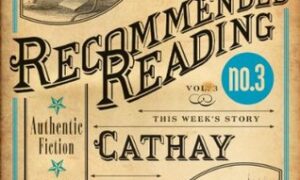 The Weight of Feathers by Anna-Marie McLemore
The Weight of Feathers by Anna-Marie McLemore
My rating: 3/5 cats



He held a wet palm to her cheek. “I don’t want you getting hurt.”
“Everybody gets hurt,” she said. “You know that.”
this isn’t the most “me” of all books, but i can definitely see its appeal for people who enjoyed books like Beautiful Creatures or The Night Circus or other stories featuring star-crossed lovers from feuding families with a fantasy/magical slant.
i snagged this one from netgalley because i liked the cover, i’d been hearing good things about it, and i’ve had good luck with circussy books so far this year (Church of Marvels, The Book of Speculation). plus, a boy with feathers growing under his hair?? that made me recall the heartbreaking feather-based magical realism of The Strange and Beautiful Sorrows of Ava Lavender, so i was sold! but this one definitely falls heavy on the “romance” side of the genre-spectrum, which is not a side i have ever been thrilled to find myself.
but if that’s your bag, you may enjoy this one.
it’s about two families: the french-romani corbeaus and the spanish palomas (avian imagery abounds), who are competing groups of traveling performers, independent of a circus or carnival. the corbeaus don giant wings constructed of wire and peacock feathers and climb trees and dance through the branches like bird-fairies while the palomas wear iridescent tails and perform in the water as sirenas, or mermaids. the families are extremely insular and superstitious and they each have specific genetic anomalies – the corbeaus grow feathers at the base of their hairline while the palomas have a scattering of scales somewhere on their bodies.
the two families have been at odds ever since an event twenty years in the past resulted in a death from each family; deaths each family blamed on the other. their feud has been sustained for all these years, with each generation being cautioned against physical contact with their enemies – to touch a member of the other family, or in some cases, to be touched by something the family owns, is to become cursed, unclean, and measures have to be taken to cleanse the taint.
–Fighting was the only safe way to touch a Paloma. Half this family believed if they ever let a Paloma brush their arm or bump their shoulder, they’d wither and die like wildflowers in July sun. But fighting was safe. The rage made it true and good. The anger and honor of defending this family shielded them like a saint’s prayer. Hitting and kicking were safe. Anything else could bring sickness.
–Lace knew the danger of touching a Corbeau. Her abuela said she’d be better off petting a rattlesnake. But these feathers were not the Corbeaus’ skin. They didn’t hold the same poison as a Corbeau’s body.
sabotage has also occurred over the years – petroleum jelly smeared on tree branches or nets placed in the water, which have resulted in injuries on both sides.
so what happens when a paloma girl and a corbeau boy meet and fall in love? why, this book is what happens.
almendro is the town where their conflict began, and it is the sole point of overlap between the families’ tour route each year. it is in this town where fate puts cluck corbeau in the path of lace paloma. neither of them realize at first that they are from enemy camps, but once they do, it is too late – sparks have flown, attraction been cemented. both cluck and lace already had tricky relationships with the rest of their families (cluck much more so) and this relationship, when it is discovered, further complicates their standings within their families. sides are taken, accusations fly, and secrets kept for twenty years are exposed. the prominent themes are loyalty and pride, family and love, and the way grudges can be sustained and the past manipulated and ingrained into family lore to justify animosity.
each chapter opens with an aphorism in either french or spanish, translated into english below. the novel itself is peppered with french and spanish phrases, also largely untranslated. naturally, i loved the frenchy bits – both the language and the little jabs at my peeeeeeeople:
–…Lace’s mother told her that tourists probably couldn’t even take their children to the Corbeaus’ show. “They’re French,” she said. “I bet they take their clothes off halfway through.”
and
“You’re blushing,” she said. “I thought you were French.”
“Not that kind of French.”
the romance elements are more strongly developed than the magical ones – i still don’t really understand WHY cluck has feathers or what lace’s mermaid-scales do, other than “that’s how this particular family is identified.” neither the feathers nor the scales have magical powers that enable the families to perform their acts – they still need to construct theatrical elements to wow the crowds and they can’t fly or breathe underwater, so their presence is strictly cosmetic and narratively extraneous, especially since they go to such great lengths to conceal these marks.
the palomas …used …plastic coins, sheer as beach glass, to cover their birthmarks. Their escalas were not some spectacle to be displayed in the show. Apanchanej, the river goddess who had blessed them with their love for water, had given them these marks, and they were not to flaunt them.
while …the blond Corbeaus coated their dark feathers in flour, to hide them. The show was all costumes and peacock feathers, lights hung in trees, tightrope walking. La magie of their bodies did not belong to the gadje, the people who were not like them.
there’s no reason this story couldn’t have been told without those elements, except that it adds a little fantasy zest to the love story.
and the love story itself is sweet, if you are a fan of romance, but there’s such an overemphasis upon smells and tastes, especially of salt, it started to annoy me. everything is salt. if you don’t believe me, here is a sampling.
He left the taste of black salt on her mouth. The woody flavor of charcoal. The sugar and acid of citrus peel. The soft metal of iron.
she has a preternaturally sophisticated palate, this one.
later, …the taste of violet-black salt still under her tongue.
and They carried the violet and ash scent of black salt.
and Her tail reminded him of raw pink salt.
and The metal-and-earth scent of violet-black salt.
and The black salt smell of his hair and sweat.
and She wanted to remember how he smelled, the salt and the cottonwood bark.
oh my god, enough with the salt already!!
there’s also a repetitive emphasis on white and black, la magia negra/la magie noire, crow and dove. i’m not sure why there was so much bird imagery on the paloma side, since their performance has nothing to do with birds or flight. or why mclemore didn’t just use a white aquatic bird like a swan if she wanted to get all birdy. unless “cisne” is not a credible surname.
but that’s just me being complainy. i did enjoy a lot of the writing, especially when it was focused on the fact that these two characters were so damaged, physically and emotionally. i thought this was lovely:
It hurt, his hands on her burns. It stung like a hot shower, pins of water and steam stabbing in. She was ready for it. The sting reminded her she was a body knitting itself back together. It was why she liked his hands on her. His wrecked fingers knew how to handle something ruined.
and overall, it’s well-written, but i value strong world-building over fantasy romance, so this one wasn’t my particular cuppa. romance fans – clamber aboard, fantasy fans – catch the next one.







